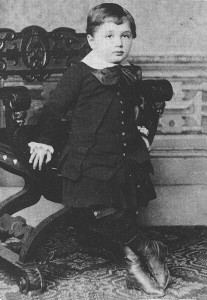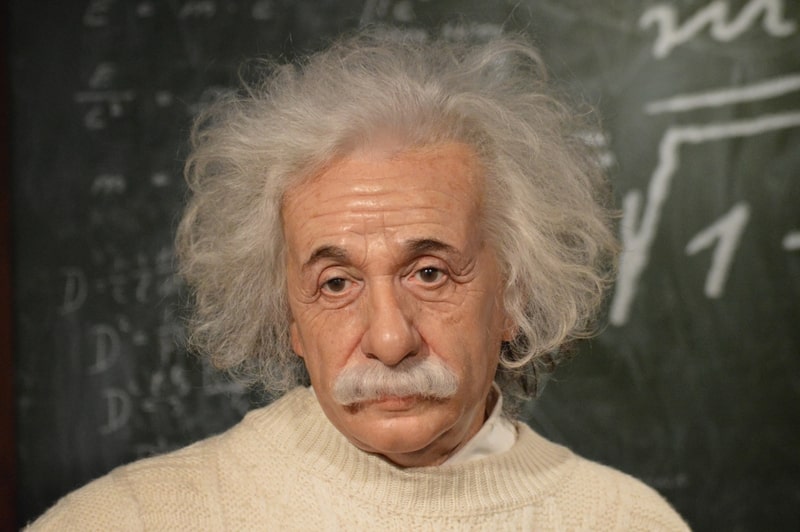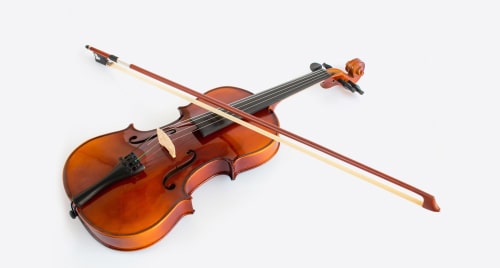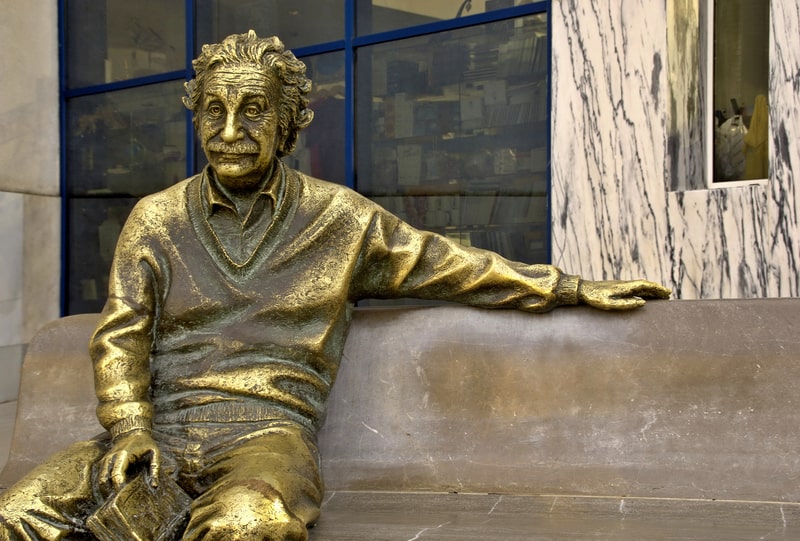Last updated on July 24th, 2022
Albert Einstein, a German-born physicist, is best known for his famous equation, which has been dubbed as ‘the world’s most famous equation’ – “E=mc2.” Albert Einstein was not very satisfied with Newtonian mechanics, as he thought that these theories were not enough to explain classical mechanics and the electromagnetic field. And this inspired him to develop his singular Theory of Relativity. With these 64 interesting facts about Albert Einstein, let us learn about his childhood, brain, theories, notable work and papers, married life, and more.
1. Born: Albert Einstein was born in Ulm, Germany to parents Hermann Einstein and Pauline Einstein. At age 29, his father married Pauline Koch. She was eleven years his junior. He was born at 11:30 am on Friday, March 14, 1879. His parents had planned to name the boy Abraham, after his paternal grandfather. But they thought that the name felt “too Jewish” and ended up naming him Albert.

The Hebrew University of Jerusalem, Israel)
2. Fathead at birth: Albert had a fat head at the time he was born. This startled his mother and grandmother when they saw him for the first time. However, the fat head slowly receded and turned into a normal size. Interestingly, a head containing the brain that would inspire millions of people in the future was not so perfect at birth.
3. Speech difficulty during childhood: Einstein did not speak until the age of three. He revealed this fact about the delay of his speech abilities to his biographer. Today there is a term, “Einstein Syndrome,” which was coined by Dr. Thomas Sowell, to describe exceptionally bright people whose speech is delayed.
4. Early years: he spent his teenage years in Munich. His family operated an electrical equipment business in the city. Einstein at a young age liked to work on puzzles, erect complex structures with his toy building sets. According to his sister Maja Einstein, Albert Einstein could erect card structures as high as fourteen stories. His ability to stay with problems longer than most others demonstrated that persistence and tenacity were already part of his character.
5. His friend: Einstein was affected by the company of a medical student whom he invited for a meal every Thursday. Talmud, the student, brought him science books, including a popular illustrated series called People’s Books on Natural Sciences. The company of these books aroused Einstein’s interest to a large extent in sciences which he pursued until the very end of his life. Talmud also introduced to Einstein the subject of geometry with a book two years before he was scheduled to learn it in school.
6. School: Einstein was not comfortable in school as he did not like the style of teaching. He did not believe in the systematic training in the worship of authority and instead promoted individuality and free thinking without any bias. He once stated, “A foolish faith in authority is the worst enemy of truth.”
7. Why he was different? His success is attributed by many to his unconventional approach to learning, challenging authority and obsessing him with mysteries that others did not find amusing. Einstein insisted on the importance of individuality.
8. A symptom of psychiatric disorder: Einstein, throughout his life, had a mild form of echolalia, which caused him to repeat phrases to himself, two or three times, especially if he liked them. He liked to think in pictures, an important tactic of some of the world’s most renowned thinkers and scientists including Nikola Tesla.
9. The parietal lobe in Einstein’s brain was 15% larger than that of an average brain.

10. Fascination for Science: the beginning of Einstein’s fascination about science came from a pocket compass, which was shown to him by his father when Einstein was five years old. He wondered what made the needlepoint in a certain direction and not anywhere else. This was the beginning of his long and illustrious career in science, which made him renowned around the world. He later quoted, “I can still remember – or at least I believe I can remember – that this experience made a deep and lasting impression on me.”
11. His favorite scientist: Galileo Galilei was Einstein’s favorite scientist.
12. Did you know that Sir Isaac Newton was born the year Galileo Galilei died and Einstein was born the year that Maxwell died?
13. Not suitable for employment: his teachers did not consider him a good student, and they refused to recommend him for further employment.
14. Failure at 16: at 16, Einstein is said to have failed an exam that would have let him train to become an electrical engineer.
15. Did you know that Einstein wrote his first essay on theoretical physics at the age of 16, which he titled “on the Investigation of the State of the Ether in a Magnetic Field.”?

16. Forgetfulness was a big part of his personality since his childhood days. He would often leave behind his suitcase and could not keep track of his keys.
17. Citizenships: Einstein was born German and a Jew. Einstein renounced his German citizenship in 1896. He became a Swiss citizen in 1901. However, he died in 1955 as an American citizen.
18. Einstein received his Swiss citizenship on the condition that he will be able to get a permanent job in the country. He also had to pay some fee to secure the citizenship. Einstein saved some amount each month so that he could pay the said fee. He wanted to be a Swiss citizen because he admired the country which respected the individuality and privacy of its residents.
19. Could not swim: Albert Einstein never learned to swim. However, he loved sailing and continued to do so as a hobby throughout his life. Also, Einstein never wore socks. He thought wearing socks was a pain, and he would often get holes in them.
20. An Avid Smoker: Einstein’s love for smoking was so enormous that he credited his pipe smoking with a calming and judgmental effect. The technique to visualize things and experiments helped him a great deal.

21. Invented refrigerator: Amazingly, Einstein also co-invented a refrigerator that would work on compressed gases. Einstein is also considered to be the man behind the inventions such as – the photoelectric cells, lasers, nuclear power, and fiber optics and even semiconductors.
22. Einstein had trouble getting an academic job. Interestingly, it took him 9 years before he could finally land at his first job after graduation from the Zurich Polytechnic in 1900.
23. Einstein got second time appointed as a Technical Expert Class 3 of the Federal Office for Intellectual Property. There he was paid 3,500 Franks annually and he had to work for eight hours every day, six days a week. He enjoyed his work to the core, which involved examining patent applications. After a few days of service, he realized that he could do the whole days work in just a few hours and thus he utilized the remaining free time at the office to do his scientific work and thinking.
24. At the age of 30, in 1909, he moved to Zurich and got appointed as a junior professor at the University of Zurich. Einstein had a distinct style of teaching. He used cards instead of papers for preparing notes and he would also note down his ideas during the lectures. Moreover, he allowed his students to interrupt him; he would also stop and ask his students if they were following him. This interaction between the teacher and the pupils was unique at the time.
25. When Einstein received his doctorate, he was promoted from a third class to a second class technical expert at the patent office and his salary was raised to 4,500 Francs a year.
26. Einstein became one of the most famous faces on the planet when his prediction that gravity bends light was confirmed during an eclipse in 1919.
27. An analytical and curious mind: Einstein was very curious and had an analytical mind at a very young age, showing great abilities in both mathematics and science. It is a common misconception or belief that Einstein failed in math during his school days. However, this is wrong. He quoted, “I never failed in mathematics. Before I was fifteen I had mastered differential and integral calculus.” According to his sister, Einstein by age 12, already had a predilection for solving complicated mathematical problems in applied mathematics. Einstein, however, had a better intuition for physics than for math.
28. Another interesting fact about Albert Einstein is that he had a poor memory. He could not remember names, dates or phone numbers.
29. The Nobel Prize in 1921: the 1921 Nobel Prize in Physics was awarded to Albert Einstein “for his services to Theoretical Physics, and especially for his discovery of the law of the photoelectric effect.”

30. Love and Hate: he loved the violin and sailing, and hated socks and haircuts. He also loved bird watching.
Related: Interesting facts about Sir Isaac Newton
31. Einstein made groundbreaking discoveries during the earlier years of his life. While he continued to perform research, he did not produce anything of significance during the later years of his life.
32. If not a scientist – a musician: Einstein was very fond of music, and his mother played a vital role in his inclination towards music. She played the violin, which became a source of enjoyment and inspiration for the young Einstein, who himself learned to play the instrument at the tender age of five. He said, “If I were not a scientist, I would be a musician.”
33. Imagination over knowledge: he always said, “Imagination is more important than knowledge, for knowledge is limited, but imagination encircles the world.”
34. Illegitimate daughter: Einstein had an illegitimate child with fellow student Mileva Maric, who later became his first wife (1903-1919). Their child is believed to have died in 1903 because of an infection just one year after her birth.
35. The second child from his first marriage with Mileva Maric was born on May 14, 1904. The couple named him Hans. His wife’s father when came to visit the couple to bless the newborn is reported to have offered Einstein a sizeable dowry of 100,000 Franks, which Einstein politely denied.
36. Conditional marriage: Einstein lived on certain conditions with his first wife, which she agreed to. Here are the terms of the marriage, which were laid down in 1914 when they were having difficulties in their relationship.
He said (conditions) in the contract, you (Mileva Maric)
A. You will make sure
- that my clothes and laundry are kept in good order;
- that I will receive my three meals regularly in my room;
- that my bedroom and study are kept neat, and especially that my desk is left for my use only.
B. You will renounce all personal relations with me insofar as they are not completely necessary for social reasons. Specifically, you will forego
- my sitting at home with you;
- my going out or traveling with you.
C. You will obey the following points in your relations with me:
- you will not expect any intimacy from me, nor will you reproach me in any way;
- you will stop talking to me if I request it;
- you will leave my bedroom or study immediately without protest if I request it.
D. You will undertake not to belittle me in front of our children, either through words or behavior.
37. Connections with women: Even after his second marriage to his first cousin, he maintained connections with six women, receiving gifts and spending time with him. This was revealed from his letters, later on.
38. Did you know that almost immediately after Albert Einstein learned of the atomic bomb’s use in Japan, he became an advocate for nuclear disarmament?
39. The miracle year 1905: this year is believed to be a miracle year in Albert Einstein’s life. He published four papers during this year, representing his most creative work. These papers were about the Quantum theory, Brownian motion (existence of atoms), Electrodynamics of moving bodies and the most famous equation in the world – the E=MC2 equation – establishing the relationship between mass and energy. At this time, he was just 26 years old and worked during the day at a patent office.

Photo 205600369 / Albert Einstein © Atlantismedia | Dreamstime.com
40. His Masterwork: Einstein considered his general theory of relativity, published in 1915, to be his masterwork. The theory was the first theory on gravity to be published in the 250 years since Sir Isaac Newton’s theory of gravity was revealed. It brought Einstein a lot of attention from all over the world. Soon, he started touring the world and began speaking in front of crowds of thousands.
41. Left Germany forever: Einstein left Germany in December 1932, a month after Adolf Hitler became the chancellor of Germany. Einstein’s move to the United States was permanent; he never entered the country of his birth again.
42. Brain preserved: In 1955, after the death of the famous physicist and scientist, his body was cremated and ashes scattered. However, the only part of his body that was retained by pathologist Thomas Harvey at Princeton Hospital while conducting his autopsy was his brain. Thomas Harvey was later fired from the hospital for not returning Einstein’s brain, which he removed during the autopsy. (Interesting facts about the brain)
43. Unified Theory: During the later years of his life, Albert Einstein was working on unified field theory. His aim was to develop a theory that would explain the entrie universe and all the laws of physics, bringing them into a single framework. However, this theory remained unfinished at the time of his death in 1955.
44. Copely Medal in 1925: the Royal Society of London awarded him its prestigious Copely Medal in 1925 for his theory of relativity and contributions to quantum theory.
. . . continue reading on the next page.
